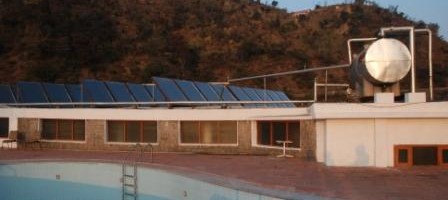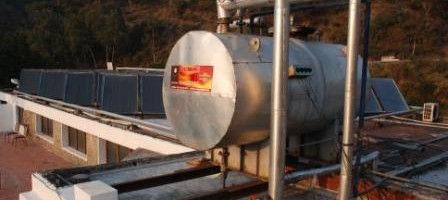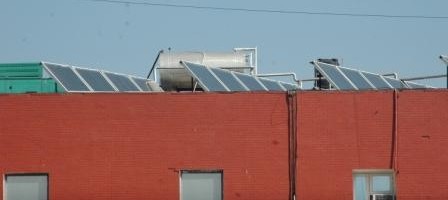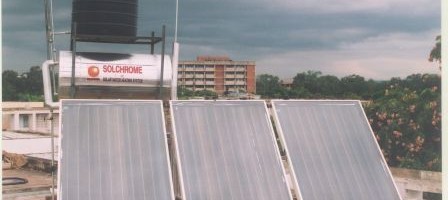Posted by admin on Jan 24, 2014 in Posts

All over India, Bangalore is the only city where maximum solar heaters are used and where solar energy is properly utilized. The use of electrical consumption has gone down, and the demand of solar water heaters is rising up to fifty percent in Bangalore. Each of the solar heaters present in Bangalore contributes to save two kilowatts of energy per hour, and there are more that 87,513 heaters present in Bangalore. By the deputy general manager of Bescom, it was made compulsory to have solar heaters in the buildings which have an area of around sixty feet to forty feet and above. There are even plans going on by the executives of Karnataka Renewable Energy Development Limited (KREDL) to install solar water heaters on government buildings to save more electricity, as well. Any person who will install solar heaters in their house can save up to Rs 1000 per month on electricity and by installing solar heaters a person can attain better quality of hot water as same as electric heating water. The exciting part is that there are no maintenance expenses for the heaters and hence it is very economical and affordable. It is advised to design and plan the architecture of the house in order to use such recourses before building a...
Read More »
Posted by admin on Jan 24, 2014 in Posts

As we all know that, to utilize solar energy we need solar panels, which help to store the energy from the sun and transfer it as per our needs. Both the panels that are used are big enough, which occupy a lot of space, and they are inconvenienced, as well. To overcome this disadvantage, a new concept of utilizing solar energy is introduced. It is called solar roof tiles. They are tiles, which can be put over the rooftop, to store energy, but one disadvantage of solar roof tiles is that more amounts of tiles are required to store some amount of energy, and it is costly, as well. Solar roof tiles facts and considerations The facts of solar roof tiles are listed below in brief. Energy efficiency and costs We should plan well about the amount of energy that the solar roof tiles can produce, and it should be limited. One solar roof tile is capable to generate power in the range of 50 to 200 watts. So in order to provide energy to a house it will take more space and to install solar roof tiles, a well-trained and professional electrician is required, so that he can connect wires from solar roof tile to different electrical appliances present at home. Enough roof space should also be considered before installing solar tiles to produce power as per our needs. How solar power roofing tiles work There are many different varieties of solar roof tiles present in the market. There are solar S tiles as well as solar flat tiles. Flat tiles are used at places where the roof is made of concrete or clay flat roofing. On the other hand, S tile is used with profiles roof tiling. New product development Many innovative products including solar shingle are going to be launched very soon. It is believed that solar shingle will be less expensive as compared to other photovoltaic options. Positive design effects There are many innovative designs in solar roof tiles. We can avail them in different colors, and we can choose them as per the requirements and design of the house. It easily blends with the texture of the home and gives a nice touch to the home. The beauty of the solar roof tiles lies in its wiring. The wiring is attached on the lower side of the solar roof tiles which hides the electrical wires from vision. The tiles are connected to each other with the help of standard...
Read More »
Posted by admin on Jan 24, 2014 in Posts
A bill was approved by the governor of Hawaii, to fix solar water heaters in every home and building, and declared it as the first state to make compulsion of these heaters. As per the bill there will be a restriction to issue permits of any buildings where there are no solar water heaters. However, there are restrictions in the bills if the houses are located in forested areas where the amount of sunshine is not proper. As per state data Hawai is the only state in all over the world which is fully dependent on fossil fuels and more than ninety percent of the energy resources are imported from other countries. Five years ago, such idea was brought by the state Sen. Gary Hooser, who is the vice chairman of energy and environment committee. It is very pleasing to know the fact that they recognized the necessity of such a bill and the benefits that are related to...
Read More »
Posted by admin on Jan 24, 2014 in Posts

If somebody asks to be energy efficient with saving of money also; the best way is to go green. That means replace less efficient conventional appliances with green options. For example replace your conventional water heater with a tankless water heater, because a conventional water heater constantly heats a complete storage tank of the heater due to which a lot of energy is wasted in maintaining heating levels. At present, many eco-friendly hot water heaters are available, out of which any can be selected according to the requirement. Tankless Water Heaters: As indicated by name, no tank is used in tankless water heaters. They provide hot water as and when required, and hence also known as a demand type unit. Tankless water heaters heated water when it passes through the heating coils contained in the unit. As it does not contain any storage tank, space as well as energy is saved which further lead to reduction of energy bills and saving of money. Solar Water Heaters: Solar water heater is the best model of green energy. They convert solar energy into heat energy for making water warm. These heaters can be used everywhere and in any climate without any fuel/ electricity. A typical solar water heater consists of solar collector panels containing tubes or coils which are placed in an area of abundant sunlight where it collects the Sun energy and transfers it to water for making it warm. There are two types of System. One is called Passive and another is Active. In a passive system, natural circulation is used for flow of water where water when gets hot, have a tendency to rise upward and collects in a storage tank. While in Active system, forced circulation is used through an external pump, for hot water circulation. This means you require reviewing the various systems that are accessible to select the best option to satisfy your hot water needs. You may also require fixing a support system to supply hot water on cloudy days and when requirement has surpassed the supply of hot water that is...
Read More »
Posted by admin on Jan 24, 2014 in Posts

In India, Bureau of Energy Efficiency (BEE) is an agency for taking care of national standards and labeling programs. In order to develop a quality standard within the solar thermal sector, The Government of India is planning to introduce a kind of “star level” for solar water heaters which would allow rating for solar water heaters. However, the solar Industries have some reservations about this program. The Indian Ministry of New and Renewable Energy (MNRE) in support with the UNDP/GEF Global Solar Water Heating (GSWH) project arranged a workshop on 22 January 2010 in Delhi to discuss the solar labeling approach with professionals/ experts of the industry which did not prove fruitful as some representatives of the industry were in the opinion that it would not be technically feasible. Even an Advisor from MNRE argued that he did not find these types of tests practical due to very high cost involved. It was also mentioned that there were methods to normalize test results and to confirm a system’s performance with repeated tests even when done so under dissimilar outdoor conditions. Another matter to be deemed was the rating of products based on other factors, such as manufacturing facilities, after-sales service and distribution network etc. In minutes of the workshop, it was concluded that a Minimum Efficiency Performance Standards (MEPS) may be initiated for SWH systems in a first stage. Initially the minimum efficiency was considered to be 40%. The MEPS level could be evaluated occasionally for advancing it to higher levels. A next action could be a label, which permits greater competition and more proficient products in the solar thermal sector. As no clear conclusion was achieved, it was suggested to establish a task force for further study regarding the introduction of MEPS and a minimum level. Afterwards, its recommendations shall be submitted to the Project Steering Committee of the GSWH project for further advice and...
Read More »


















Recent Comments